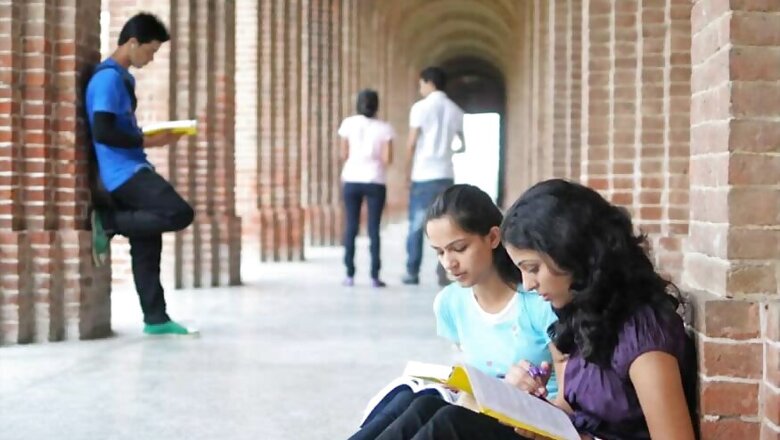Budget 2019: Experts Say 6% of GDP Should be Spent on Education; Focus Must Shift From IITs and IIMs

views
New Delhi: It was in 1964 that the Kothari Commission recommended allocation of 6 per cent of GDP on education. Decades later, ahead of the Union Budget, policy experts and academicians are raising the demand for the government to finally implement the recommendation, especially when there is an upsurge in enrolment and number of institutes.
As per the All India Survey on Higher Education 2017-18, Gross Enrolment Ratio (GER) in higher education in India is 25.8 per cent, which is calculated for 18-23 age group. In 2016-17, the GER was 25.2 per cent, also calculated for the same age group.
In 2015-16, GER in higher education in India was 24.5 per cent, again calculated for 18-23 years of age group.
Seeing this enhancement, there is reiteration of the old demand to increase the budget for education. Dr Pankaj Mittal, secretary general of the Association of Indian Universities and Additional Secretary University Grants Commission said, “The Kothari Commission recommendation was to have 6% of GDP allocated for education, but we have done nothing about it.”
In fact, the share of education spending in total Union budget has decreased from 4.6 per cent in 2014-15 to 3.5 per cent in interim budget of 2019-20.
“When we have the enhanced budget then almost 25% of it should go to higher education. The impetus must be given to social sciences,” she added. The AISHE reports 2017-18 mentioned that at undergraduate level the highest number (36.4%) of students are enrolled in arts/humanities/social sciences courses, this is followed by science (17.1%), engineering and technology (14.1%) and commerce (14.1%).
The increased allocation of the GDP is necessary to focus on the “lower rung” universities. Mittal added, “The budget must focus on colleges and state universities that cater to the masses. There has to be a policy shift from elite institutions to the ones in remote and rural areas. With more funds, we can bridge the gap that exists between the elite and the lower rung state universities and colleges that catch masses. This is important as it is the lower rung that the mass graduates are produced.”
Pushing a case for shift from elite institutes she further added, “All the elite institutions put together are not bringing out the students that colleges and state universities are – the 95% of the enrolment is in rest of the institutions, away from all your IITs and IIMs put together.”
The comment gets more support from the various reports. The Centre for Budget and Governance Accountability in the report “Numbers That Count - An Assessment of the Union Budgets of NDA II” observed: “The NDA government has always promoted technical education over general education. As a result, in the last five years, seven IITs, seven IIMs, fourteen IIITs, have been set up or are in the process of being set up.”
The report shared, “Between 2014-15 and 2019-20, the allocations to the IITs have increased by around 60 per cent. The cabinet approved the IIM bill in 2017. To improve quality of institutes of higher education, last year government came up with a plan for graded autonomy of colleges and universities based on the performance of these institutes.”
Also six public and six private universities including IIT, IISCs have been chosen as ‘institute of eminence’ and thus received a 210 per cent increase in resource allocation in 2019-20 (BE).
The report had observed in February 2019, “However, the state universities and colleges which cater the larger share of student, have received lesser share of higher education budget. The budget for Rashtriya Uchchatar Shiksha AbhiyanRUSA in 2019-20 (BE) has increase only by Rs. 600 crores from the previous year’s revised estimates.”
The Rashtriya Uchchatar Shiksha Abhiyan (RUSA) is a Centrally Sponsored Scheme (CSS), launched in 2013 aims at providing strategic funding to eligible state higher educational institutions. The central funding (in the ratio of 60:40 for general category states, 90:10 for special category states and 100% for union territories) would be norm based and outcome dependent.
In one of his interviews to News 18.com, Former VC of National University of Educational Planning, Professor R Govinda said that the Indian higher education is a multi-layered situation, “Institutions like IITs and IIMs are very few – specialized largely having a single focus area. In reality the major part of enrolment is in affiliated colleges, which is an outdated colonial vestige and no other country has this model. It is time we give up our obsession with elite institutions.”
In his opinion the elite institutions can take care of themselves as these institutions and the few central universities form a miniscule part of the Indian higher education system. At present, India has more than 903 Universities, 39050 Colleges and 10011 stand alone institutions across the country.
Govinda added, “The larger system accounting for more than 90 percent of enrolment need urgent attention and require radical action to set right the course of development. In fact, inadequate supply of qualified human resources is already stalling economic growth prospects. We have to attend to the hinterland of higher education not just the frontiers.”
There has been an upsurge in the demand for higher education, which is reflected in the increase in enrolment and infrastructure facilities for higher education in the country. The budget has to reflect the commitment to higher education, which has been eluding the sector for longest time.


















Comments
0 comment